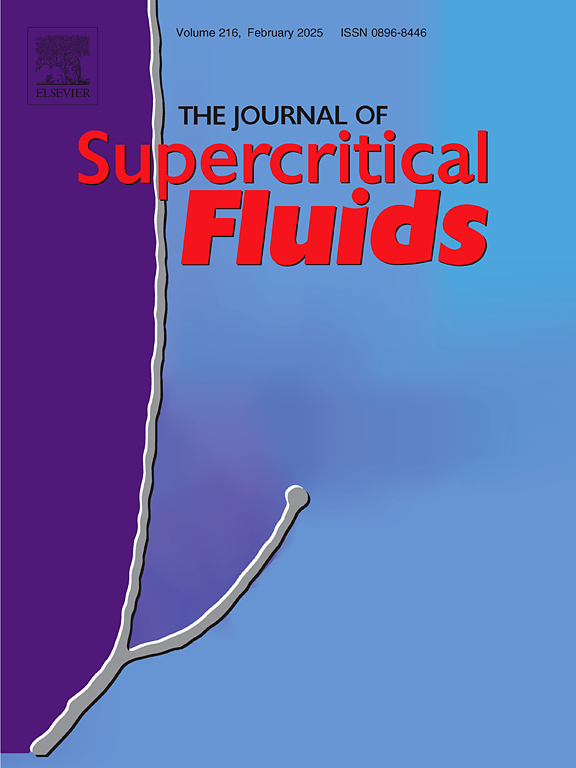Performance of oil well cements before and after being exposed to supercritical CO2: Evaluation of combined chemical additives
IF 3.4
3区 工程技术
Q2 CHEMISTRY, PHYSICAL
引用次数: 0
Abstract
In this study the individual effects of water/binder (0.44, 0.35, 0.30, and 0.25), polycarboxylate superplasticizer- PCE (0.07 wt%, 0.14 wt%, and 0.21 wt%), defoamer-DF (0.5 % and 1 %), and silica fume-SF (10 wt%, 15 wt%, and 20 wt%) admixtures in oil well cement Class G properties were investigated before and after exposure to CO2 under high pressure and high temperature (HPHT) of 150 bar and 70°C. Spread diameter, compressive strength, Brunauer-Emmett-Teller (BET), X-ray diffraction (XRD), and thermogravimetric analysis (TGA) were used for characterization. Moreover, the microstructure of the samples was observed with scanning electron microscopy (SEM). The results reveal that the w/b ratio is a crucial factor for improving cement paste properties, with lower ratios resulting in lower porosity (higher carbonation resistance) and higher compressive strength. PCE enhances dispersion and cohesion, with optimal results achieved at a low w/b ratio (0.25). Although high dosages of PCE increased carbonation depth, they significantly improved the workability. DF reduces air incorporation, increasing cement matrix density, compressive strength, and resistance against CO2 attack. SF significantly improves mechanical properties and microstructure, especially at higher addition levels. However, as SF is added, the higher the carbonation depth. Additionally, the synergistic behavior of additives was evaluated after determining the optimum value for each one. The optimal mixture with the lowest water/binder ratio and highest PCE, DF and SF amounts achieved improved properties in the hardened state with good slurry workability. It also provided the lowest carbonation depth under geological carbon storage conditions.
油井水泥在超临界CO2作用前后的性能:复合化学添加剂的评价
在这项研究中个体的影响水灰(0.44,0.35,0.30和0.25),polycarboxylate强塑剂- PCE(0.07 wt %, 0.14 wt %,和0.21 wt %), defoamer-DF(0.5 % 1 %),和二氧化硅fume-SF(10 wt %, 15 wt %,和20 wt %)在油井水泥外加剂类G属性进行调查之前和之后暴露在二氧化碳在高压和高温(采用HPHT) 150年 酒吧和70°C。扩散直径、抗压强度、布鲁诺尔-埃米特-泰勒(BET)、x射线衍射(XRD)和热重分析(TGA)对材料进行了表征。并用扫描电子显微镜(SEM)观察了样品的微观结构。结果表明,水灰比是改善水泥浆体性能的关键因素,水灰比越低,水泥浆体孔隙率越低(抗碳化能力越强),抗压强度越高。PCE增强了分散和凝聚,在低w/b比(0.25)时达到最佳效果。虽然高剂量的PCE增加了碳化深度,但它们显著改善了和易性。DF减少空气掺入,增加水泥基质密度、抗压强度和抗CO2侵蚀能力。SF显著改善了机械性能和微观结构,特别是在高添加水平下。但随着SF的加入,碳酸化深度越高。此外,在确定了每种添加剂的最优值后,评估了添加剂的协同行为。水胶比最低,PCE、DF和SF用量最高的最佳混合料在硬化状态下性能得到改善,浆体和易性良好。它还提供了地质储碳条件下的最低碳酸化深度。
本文章由计算机程序翻译,如有差异,请以英文原文为准。
求助全文
约1分钟内获得全文
求助全文
来源期刊

Journal of Supercritical Fluids
工程技术-工程:化工
CiteScore
7.60
自引率
10.30%
发文量
236
审稿时长
56 days
期刊介绍:
The Journal of Supercritical Fluids is an international journal devoted to the fundamental and applied aspects of supercritical fluids and processes. Its aim is to provide a focused platform for academic and industrial researchers to report their findings and to have ready access to the advances in this rapidly growing field. Its coverage is multidisciplinary and includes both basic and applied topics.
Thermodynamics and phase equilibria, reaction kinetics and rate processes, thermal and transport properties, and all topics related to processing such as separations (extraction, fractionation, purification, chromatography) nucleation and impregnation are within the scope. Accounts of specific engineering applications such as those encountered in food, fuel, natural products, minerals, pharmaceuticals and polymer industries are included. Topics related to high pressure equipment design, analytical techniques, sensors, and process control methodologies are also within the scope of the journal.
 求助内容:
求助内容: 应助结果提醒方式:
应助结果提醒方式:


